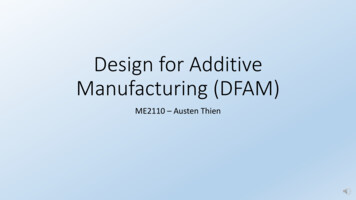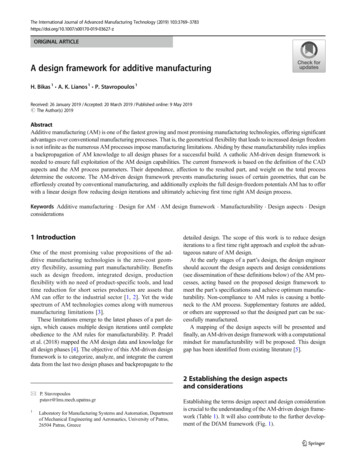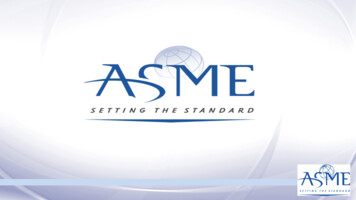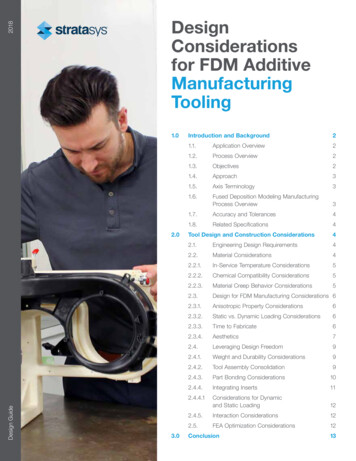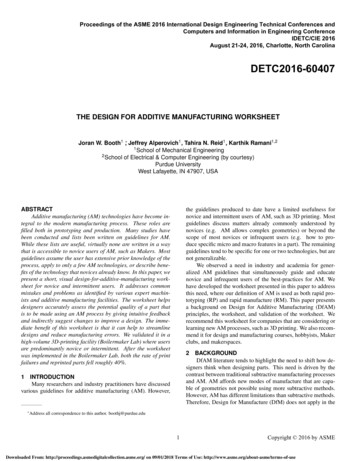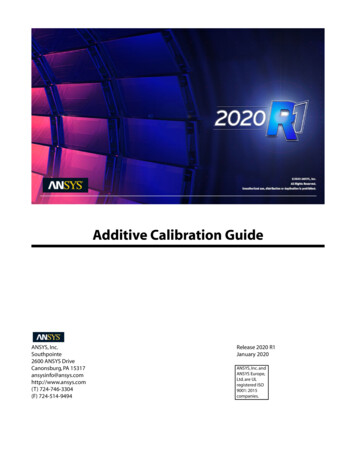
Transcription
A design framework for additive manufacturing based on the integration ofaxiomatic design approach, inverse problem-solving and an additive manufacturingdatabasebySarath RenjithA thesis submitted to the graduate facultyin partial fulfillment of the requirements for the degree ofMASTER OF SCIENCEMajor: Industrial EngineeringProgram of Study Committee:Gül Erdem Okudan Kremer, Major ProfessorMichael Scott Helwig, Committee MemberMark Mba-Wright, Committee MemberThe student author, whose presentation of the scholarship herein was approved by theprogram of study committee, is solely responsible for the content of this thesis. TheGraduate College will ensure this thesis is globally accessible and will not permitalterations after a degree is conferred.Iowa State UniversityAmes, Iowa2018Copyright , Sarath Chennamkulam Renjith, 2018. All rights reserved.
iiTABLE OF CONTENTSPageLIST OF FIGURES . iiiLIST OF TABLES . viiACKNOWLEDGMENTS . viiiABSTRACT . ixCHAPTER 1. INTRODUCTION . 10CHAPTER 2. LITERATURE REVIEW . 132.1 Design for Additive Manufacturing (DfAM) . 132.2 Additive Manufacturing Capabilities . 22CHAPTER 3. METHODOLOGY . 433.1 Axiomatic design approach . 433.2 Inverse problem-solving approach based on TRIZ . 463.3 Additive manufacturing database . 493.4 Proposed design framework . 523.4.1 Conceptual design phase . 533.4.2 Embodiment design phase . 553.4.3 Detailed design phase . 56CHAPTER 4. CASE STUDIES . 574.1 Case study 1: Redesigning a housing cover . 574.1.1 Conceptual design phase . 584.1.2 Embodiment design phase . 614.1.3 Detailed design phase . 634.2 Case study 2: Redesigning a link-pin assembly . 654.2.1 Conceptual design phase . 654.2.2 Embodiment design phase . 694.2.3 Detailed design phase . 71CHAPTER 5. DISCUSSION & CONCLUSIONS . 74REFERENCES . 77APPENDIX A. . 87APPENDIX B. . 88
iiiLIST OF FIGURESPageFigure 1 Powder-based additive manufacturing process. Adopted from Poprawe(2005). . 10Figure 2 Design methodology proposed by Rodrigue and Rivette (2010). . 15Figure 3 Redesigning a square bracket using parametric optimization. Adopted . 15Figure 4 Designing a salt shaker and ice cream scoop with and without using theDfAM database. Adopted from Bin Maidin et al. (2012). . 17Figure 5 A salt cellar and its 3D modular graphical representation. Adapted fromBoyard et al. (2015). . 18Figure 6 Modified turbine blade with integrated ink cartridge designed by the forcedassociation of a turbine blade (AM domain) and ball point ink pen(another domain). Adopted from Rias and Segonds (2016). . 19Figure 7 3D printed lamp designed by Bathsheba Grossman (Materialise, 2008) (a)and a 3D printed removable partial framework model (Stratasys,2017a). . 23Figure 8 A lattice cell made using a laser fusion process (Petrovic et al., 2011) (a),acetabular cup with porous lattice structure (Sing et al., 2016) (b) and atibial stem made using Electron Beam Melting process (Murr et al.,2012) (c). . 24Figure 9 Topology optimization process of a metal bracket. Adopted from Komi(2014). . 26Figure 10 Example of part consolidation. An aircraft duct with 16 components (a)consolidated into a single component (b) (Gibson and Rosen, 2015). . 27Figure 11 A pulley driven snake like robot made using stereolithography (a)(Gibson and Rosen, 2015), gear trains made of aluminum alloys with0.8 mm clearance (b) (Calignano et al., 2014), a 13 piece articulatingsection made using laser sintering (c) (Zelinski, 2012) and a universaljoint fabricated with Vero-white material (d) (Chen and Zhezheng,2011) . 28
ivFigure 12 Injection mold insert with cooling channel (Gibbons and Hansell, 2005)(a), hydraulic valve block (b) (Komi, 2014), and robot arm withinternal air ducts (EOS GmbH, 2014) (c)(d) . 29Figure 13 Printed parts of a chair and the assembled chair (a) (Luo et al., 2016).Printed cantilever snap-fit (b) (Low, 2018) . 31Figure 14 Mold with conformal cooling channels (Campbell et al., 2013) . 32Figure 15 Wind turbine with 3D printed modular parts (Kostakis et al., 2013),dielectric pillars directly fabricated over a silicon chip (Rahman et al.,2015) (b), printed object with hair like structures (Ou et al., 2016) (c),hearing aid cap with 200μm diameter holes (Bertsch et al., 2000)(d). 33Figure 16 Ice cream cup with surface texture (a) (Van Rompay et al., 2018), 3Dprinted motorcycle hand-grip (b)(Moto3designs, 2017), jewelry modelbuilt on a Solidscape 3D printer (c) (Rhinojewel, 2018), 3D printed text(d) (Sculpteo, 2018). . 34Figure 17 Example of materials suitable for 3D printing along with their properties.Copyright (Senvol LLC, 2018). 35Figure 18 GPS device prototype printed using Poly-jet multicolor printing (a)(Stratasys, 2017b), globe printed using a dual-extruder printer (b)(Hergel and Lefebvre, 2014), and a carbon fiber reinforced part withnylon outer shell (Alex Crease, 2016) (c). . 36Figure 19 Infill percentages and infill patterns (3DPlatform, 2018) . 37Figure 20 Stair-case effect on a 3D printed frog (Francois, 2013). . 39Figure 21 Axiomatic design approach of mapping functional requirements, designparameters and process variables (Salonitis, 2016) . 44Figure 22 Hierarchical structure of functional requirements and design parameters(Shirwaiker and Okudan, 2008) . 44Figure 23 Defining the design problem in the axiomatic design structure in terms ofFRs, DPs and AMCs. 46Figure 24 Inverse problem-solving approach. Adapted from Rodrigue and Rivette(2010). . 48Figure 25 Home screen of the database with "search" feature . 50Figure 26 Search results for "remove material" shown in Figure 25. . 51
vFigure 27 Flowchart of the proposed design framework . 52Figure 28 Searching the keyword in the additive manufacturing database (a), searchresults (b) and detailed description of the additive manufacturingcapability (c). . 54Figure 29 A functional diagram of a wheel by Cascini et al. 2004. The componentsof wheel (rim, spoke and hub), their actions and their interactions. . 54Figure 30 Initial design (isometric view on the left and cross-sectional view on theright) of the housing cover . 57Figure 31 The initial design of the part and the functional analysis of its components(Housing cover, gasket and threaded socket) . 57Figure 32 Hierarchical structure of functional requirements, design parameter andprocess variables . 60Figure 33 Initial design of the housing cover (left). Consolidated design of thehousing cover (right) . 61Figure 34 Consolidated design of the housing cover (left). Modified design of thehousing cover with thin fins (right) . 62Figure 35 Modifying the internal structure of the part by adding a lattice structure(cross-sectional view of the housing cover). . 63Figure 36 Thermal analysis on the design without fins and with fins . 63Figure 37 CAD Design and polymer 3D printing example for a link-pin assembly ina hydraulic pump . 66Figure 38 Result summary of conceptual design phase . 66Figure 39 Derivation of an additive manufacturing capability for material removal . 68Figure 40 Initial design of the assembly (a) and consolidated design of the assembly(b) . 70Figure 41 Consolidated design of the assembly (a), finite element analysis on theconsolidated design (b), topologically optimized shape of the part andthe design after material removal (d) . 71Figure 42 Final part design derived in detailed design phase . 72Figure 43 Table in MS Access with additive manufacturing capabilities. . 87
viFigure 44 Additive manufacturing capability with detailed information. . 88
viiLIST OF TABLESPageTable 1 DfAM approaches in literature . 14Table 2 Summary of additive manufacturing capabilities reviewed . 40Table 3 Inverse problems solving method . 49Table 4 Deriving solutions using inverse problem-solving approach . 60Table 5 Comparison between original and redesigned parts . 64Table 6 Deriving solutions using inverse problem-solving approach . 69Table 7 Comparison between original and redesigned parts . 73
viiiACKNOWLEDGMENTSFirst, I would like to thank my research advisor Dr. Gül Kremer, for her guidance,motivation, expertise and encouragement throughout my graduate career. I am grateful tohave her as my advisor and she has been a tremendous source of inspiration. I have beenfortunate to take some wonderful classes during my graduate studies at Iowa StateUniversity, especially with Dr. Michael Helwig, and Dr. Mark Mba-Wright and I wouldlike to extend my sincere gratitude to them for being my committee members and fortheir guidance and support throughout the course of this research.I would also like to express my special gratitude to Dr. Kijung Park for hisguidance on my research. Without his valuable comments, suggestions and advice, thisresearch would not have been possible. I am also grateful to Dr. Elif Elcin Günay for hersupport during the course of this research.I would also like to thank IISE and ISERC 2018 for providing me an opportunityto present and discuss the preliminary work of this thesis.In addition, I would also like to thank my friends, colleagues, the departmentfaculty and staff for making my time at Iowa State University a wonderful experience. Iwould also like to thank my parents for facilitating all my needs and for their continuouslove and support throughout my life.This work was partially funded by the National Science Foundation under awardnumber DUE-1723736. Any opinions, findings, conclusions and/or recommendationsexpressed in this paper are those of the author’s and do not necessarily reflect the NSF’sviews.
ixABSTRACTAdditive manufacturing has emerged as an integral part of modern manufacturingbecause of its unique capabilities and has already found its applications in variousdomains such as aerospace, automotive, medicine, and architecture. In order to take thefull advantage of this breakthrough manufacturing technology, it is imperative thatpractical design frameworks or methodologies are developed. Consequently, Design forAdditive Manufacturing (DfAM) has risen to provide a set of guidelines during theproduct design process. The existing DfAM methods have certain limitations in that thecapabilities of an additive manufacturing process are not effectively considered in theearly design stage, and most of them rely on the direct application of existing methods forconventional manufacturing. Furthermore, existing DfAM methods lack suitability foradditive manufacturing novices. To tackle these issues, this study develops a designframework for additive manufacturing through the integration of axiomatic designapproach and theory of inventive problem-solving (TRIZ) with the consideration ofadditive manufacturing environment. This integrated approach is effective because anaxiomatic design approach can be used to systematically define and analyze a designproblem, while the inverse problem-solving approach of TRIZ combined with an additivemanufacturing database can be used as an idea generation tool that can generateinnovative solutions for the design problem. Two case studies are presented to apply andvalidate the proposed design framework.
10CHAPTER 1.INTRODUCTIONAdditive manufacturing refers to a group of technologies that can build threedimensional solid objects from their digital models by selectively accumulating materiallayer-by-layer (SME, 2018). The process of additive manufacturing takes information fromthe computer aided design (CAD) model of an object and converts it into thin ‘slices’ thatcontain information of each layer to be printed. The CAD model is then built by an additivemanufacturing machine one slice at a time with each subsequent slice built on the previousone (see Figure 1) (Wong and Hernandez, 2012; Diegel et al., 2010). Additivemanufacturing has emerged as an integral part of modern manufacturing because of its abilityto fabricate complex shapes (i.e., design freedom), to consolidate separated parts into oneintegral part, and to create sustainable products by reducing their environmental impact(Rosen, 2014; Salonitis, 2016). These unique capabilities of additive manufacturing havefound their applications in various domains such as aerospace, automotive, healthcare, andarchitecture (Wong and Hernandez, 2012).Figure 1 Powder-based additive manufacturing process. Adopted from Poprawe (2005).With the capabilities of additive manufacturing, it is necessary to havepractical design frameworks or methodologies that enable designers or engineers to generate
11effective product designs for additive manufacturing (Diegel et al., 2010). In this regard, theconcept of Design for Additive Manufacturing (DfAM) has risen to provide a set ofguidelines and tools that facilitate the consideration and evaluation of constraints andcapabilities in additive manufacturing during a product design process (Diegel et al., 2010;Laverne et al., 2014). However, DfAM approaches in literature tend to rely on the directapplication of existing methods for conventional manufacturing without their appropriatetransition for additive manufacturing (Salonitis, 2016). Also, the existing DfAM frameworksdo not sufficiently reflect the process capabilities and constraints of additive manufacturingin the early design phase (Laverne et al., 2015); in fact, few DfAM methodologies make useof design problem analysis tools in order to systematically approach the design problem(Kumke et al., 2016). Furthermore, there is a lack of methods that enable additivemanufacturing novices to generate creative design solutions (Booth et al., 2017; Rias andSegonds, 2016).To tackle the above issues in DfAM, this study aims to develop a designframework for additive manufacturing through the integration of axiomatic design andinverse problem-solving in the theory of inventive problem-solving (TRIZ), that is facilitatedthrough a database system for additive manufacturing capabilities. The main objective of theframework is to help users to systematically analyze design problems and thereby to developinnovative design solutions by identifying the suitable additive manufacturing capabilities. Inthe proposed framework, an axiomatic design approach is used to systematically define adesign problem in terms of functional requirements, design parameters, and correspondingadditive manufacturing capabilities. Under a defined design problem structure, an inverseproblem-solving approach based on TRIZ is used to derive design parameters that can satisfy
12initially defined functional requirements. Then, a database system searches appropriateadditive manufacturing capabilities corresponding to the design parameters, so that users caneasily identify effective additive manufacturing solutions to realize the product design. Theproposed methodology, by considering additive manufacturing capabilities in the earlydesign phase, allows designers who are not familiar with additive manufacturing to leveragethe potentials of additive manufacturing. This design framework can be used to redesignexisting products that are designed for conventional manufacturing as well as to design newproducts to be manufactured using additive manufacturing technologies.The thesis is structured as follows: Chapter 2 comprehensively reviews the existingliterature on Design for Additive Manufacturing (DfAM) and the additive manufacturingcapabilities in subsections 2.1 and 2.2, respectively. Chapter 3 discusses the proposedmethodology in detail through four subsections. Section 3. 1 discusses the axiomatic designapproach used to systemically structure a design problem, Section 3.2 discusses the inverseproblem-solving method based on TRIZ used to derive design parameters that can satisfyinitially defined functional requirements, Section 3.3 discusses the additive manufacturingdatabase system used to identify additive manufacturing capabilities corresponding to thedesign parameters, and Section 3.4 proposes a design framework that integrates the axiomaticdesign approach, the inverse problems solving method, and the additive manufacturingdatabase. Chapter 4 applies the proposed DfAM framework to two case studies todemonstrate the application of the framework. Finally, Chapter 5 discusses results from thetwo case studies and provides conclusions with limitations and future work.
13CHAPTER 2.LITERATURE REVIEW2.1 Design for Additive Manufacturing (DfAM)Laverne et al. (2014) defined Design for Additive Manufacturing (DfAM) as a set ofmethodology and tools that helps designers to take the specificity of additive manufacturinginto consideration during a product design stage. These methods enable designers to exploitthe unique capabilities of additive manufacturing, so that they can create an additional valuefor manufacturers and users (Klahn et al., 2015). Kumke et al. (2016) classified the DfAMapproaches in literature into two categories: DfAM for design decisions and DfAM formanufacturing decisions. Design approaches for additive manufacturing that comprise ofguidelines, rules, and methodologies to support designers to utilize the design potentials ofadditive manufacturing fall in the former category. The latter category includes upstream,downstream, and other generic DfAM related activities carried out in a new productdevelopment processes such as activities concerning the manufacturing process itself (e.g.,process selection, selection of part candidates) that are performed by manufacturingspecialists instead of design engineers.This study focuses on the DfAM approaches in literature that belong to DfAM fordesign decisions. Recent DfAM approaches in this category are summarized in Table 1. Ageneral design methodology comprises of three main phases; 1) conceptual design phase,where the basic solution principles for a design problem are identified to derive initial designconcepts, 2) embodiment design phase, where most of the design engineering work is doneby incorporating the solution principles, and 3) detailed design phase, where the design isrefined to satisfy the design parameters and requirements such as tolerance, loadingconditions, and process specifications (Laverne et al., 2015).
14Table 1 DfAM approaches in literatureDesignproblemanalysis toolIdeagenerationtoolRodrigue et al., 2010 Maidin et al., 2012 AuthorsVayre et al., 2012Boyard et al., 2013Parametricoptimization3D modulargraphDesign phaseconsideredCEDAMCs consideredin conceptualphase?TRIZ Design featuredatabase Klahn et al., 2015 Laverne et al., 2015 Brainstorming Salonitis et al., 2015Kumke et al., 2016SpecificationanalysisDfAM ciationRias et al., 2016 Salonitis et al., 2016Axiomaticdesign Kamps et al., 2017TRIZBiomimicrydatabase *C conceptual phase, E embodiment phase, D detailed phase, not covered, partially covered, covered in detail, AMC additive manufacturing capabilityDifferent design frameworks in the literature focus on one or multiple general design phasesby incorporating the existing design problem analysis tools and idea generation tools intotheir design frameworks. Rodrigue and Rivette (2010) proposed a design methodology foradditive manufacturing that combines the benefits of Design for Assembly (DFA) andDesign for Manufacturing (DFM) (see Figure 2). The process begins by determining the partsof an assembly that can be consolidated, and a product is then redesigned by consolidatingthose parts. Next, the functions and characteristics of the parts for user requirementsatisfaction and design failure prevention are identified using TRIZ and are optimized using a
15Finite Element Analysis (FEA) software. This step follows the selection of materials basedon the functions and characteristics identified in the previous step. The primary focus of thisapproach is the embodiment design phase, and it does not elaborate on how the appropriateadditive manufacturing capabilities are identified for each feature to be optimized.Material selectionDesign concept anddraft of assemblyConsolidation of partsDetailed final designOptimize functions andcharacteristicsFigure 2 Design methodology proposed by Rodrigue and Rivette (2010).Vayre et al. (2012) claim that additive manufacturing is a breakthrough in manufacturing, butit is yet to be followed by a breakthrough in the designing process. They proposed a generaldesign methodology for additive manufacturing, involving analysis of part specifications,generation of initial shapes, analysis of these shapes based on geometrical parameters, andoptimizing the shape by tuning up the parameters (Figure 3).Figure 3 Redesigning a square bracket using parametric optimization. Adoptedfrom Vayre et al. (2012).Salonitis and Zarban (2015) proposed a methodology to redesign existing componentsfor additive manufacturing, which begins with the evaluation of additive manufacturingprocess specifications and functional requirements of the part. This is followed bytopological optimization to remove unstressed material from a part to derive initial conceptsand a multi-criteria decision analysis to evaluate design alternatives. Focusing on the
16embodiment and detailed design phases, these studies do not explicitly describe how thecapabilities of additive manufacturing can be effectively determined to optimize designparameters.Salonitis (2016) proposed a design framework for additive manufacturing usingaxiomatic design theory where the functional requirements are mapped to design parametersand process variables through a zig zag decomposition method. Design solutions wereevaluated using the independence axiom and information axiom of axiomatic design theory.This design framework focuses on the conceptual design phase, and it does not discuss howto systematically map functional requirements into design parameters and process variables.Kamps et al. (2017) proposed a creative design methodology that incorporates biomimicryand TRIZ for part optimization. The steps in the design framework include part analysis,functional analysis of the main and subfunctions of the components using TRIZ, abstractbiomimetic design (database augmented analogy search for each function), and final partdesign. The methodology was demonstrated by redesigning a gear wheel. Six functions(torque transmission, mass reduction, friction reduction, mechanical stability, heat transferand damping) were identified through the functional analysis. A biomimetic analogy searchfor each of these functions was conducted. The design solutions were identified by selectinga biomimetic-analogy for each of the functions. This framework demonstrates the benefit ofusing an existing design problem analysis tool in the conceptual design stage tosystematically define and understand the design problem.Bin Maidin et al. (2012) developed an additive manufacturing design feature databaseto support new product development and to inspire designers during the conceptual designphase. The authors identified a total of 113 additive manufacturing enabled design features
17from case studies in literature and organized these into a taxonomy with four top-levelcategories; user fit requirement, improve functionality requirement, consolidationrequirement, and aesthetics requirement. The effectiveness of the database was determinedthrough user trials and feedback from respondents who indicated that the database toolenabled them to access more information (i.e., additive manufacturing enabled features)during the design process. Figure 4 shows two products that were designed during the usertrials. The trials showed that the tools provided various ideas and features for the productdesigns. This study demonstrates that the use of an idea generation tool in the conceptualdesign phase could be effective to incorporate additive manufacturing capabilities intoproduct design.Figure 4 Designing a salt shaker and ice cream scoop with and without using the DfAMdatabase. Adopted from Bin Maidin et al. (2012).Boyard et al. (2015) proposed a five-step design methodology including identificationof functional specifications, conceptual design, architectural design, detailed design, andimplementation. The authors performed loops of Design for Manufacturing (DFM) andDesign for Assembly (DFA) in parallel during the architectural design and detailed designstages of a design process. They used a 3D modular graph to represent a product (See Figure
185). Each function (of the product) is represented as a sphere and the functions are groupedinto sets. The segments indicate the direct connections between the functions and the 3Dmodular graph represents the spatial organization of the functions with each other.According to the authors, this modular representation allows reconfiguration of the design, ifnecessary, during discussion of conceptual design with the stakeholders.Figure 5 A salt cellar and its 3D modular graphical represen
A design framework for additive manufacturing based on the integration of axiomatic design approach, inverse problem-solving and an additive manufacturing database by Sarath Renjith A thesis submitted to the graduate faculty in
